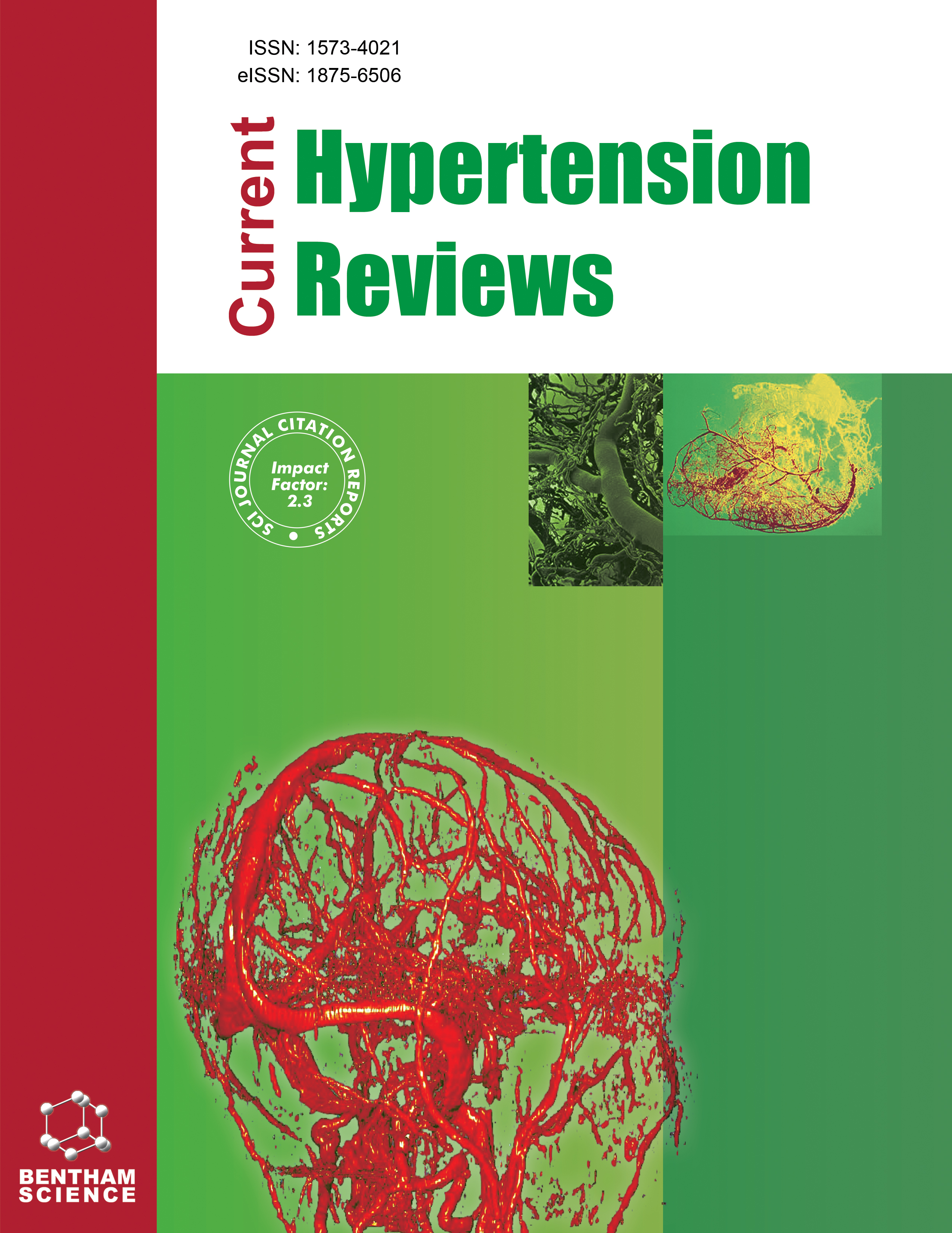- Home
- A-Z Publications
- Current Hypertension Reviews
- Previous Issues
- Volume 6, Issue 4, 2010
Current Hypertension Reviews - Volume 6, Issue 4, 2010
Volume 6, Issue 4, 2010
-
-
New Advances in Blockade of the Renin-Angiotensin System - the Role of Direct Renin Inhibition
More LessAuthors: Louise F. Clark, Gordon F. Rushworth, Stephen J Leslie and Sandra MacRuryDirect Renin Inhibitors (DRIs) are a new class of medication, and are the first which block the rate-limiting step of the renin-angiotensin-aldosterone-system (RAAS). Aliskiren, the first licensed orally active DRI, has been shown to be an effective antihypertensive agent. This review article outlines the pharmacological basis for DRI therapy, from discovery of the class to ongoing clinical trials and novel therapeutic app Read More
-
-
-
Hypertension: Basics Concepts and the Evolving Role of Novel Treatments
More LessAuthors: Marie-Francoise Doursout, Emil Martin, Iraida Sharina, Ka Bian and Ferid MuradHypertension, a major cardiovascular risk factor, is the primarily cause of mortality worldwide. A large body of evidence indicates that patients with essential hypertension, and even more those with complicated hypertension, are characterized by endothelial dysfunction due to impaired nitric oxide (NO) availability secondary to oxidative stress production. Therefore, a dysfunctioning endothelium is an early marker in the devel Read More
-
-
-
A Proposal----The Renal Kallikrein-Kinin System as a Compensating System for Salt Accumulation after Excess Salt Intake
More LessAuthors: Makoto Katori and Masataka MajimaTerrestrial mammals, like human, must reserve water and NaCl to counter the effects of dry-environments. Their kidneys need to reabsorb as much water and sodium as possible along the proximal tubules and collecting duct. Thus, excess sodium intake tends to sodium accumulation in the body. The renal (tissue) kallikrein-kinin system (KKS) exists to prevent excessive sodium reabsorption. Renal kallikrein is secreted from the dist Read More
-
-
-
Clinical Significance of the Cardio-Ankle Vascular Index (CAVI) in Hypertension
More LessAuthors: Kazuhiko Kotani, Michiaki Miyamoto and Nobuyuki TaniguchiIncreased blood pressure and hypertension are a major atherosclerotic risk factor. Arterial stiffness is recognized to be reflective to the atherosclerotic states. The pulse wave velocity (PWV) is a noninvasive, simple, easy and reproducible index that can be used to assess arterial stiffness in association with blood pressure. The cardio-ankle vascular index (CAVI) has recently been developed to evaluate arterial stiff Read More
-
-
-
Cardiovascular Disease in Masked Hypertension: Clinical Implications
More LessAuthors: Cheol Ung Choi and Chang Gyu ParkIn this review, we describe target organ damage and cardiovascular events in masked hypertension. Masked hypertension is associated with more target organ damage, including sustained hypertension, left ventricular hypertrophy, carotid atherosclerosis, microalbuminuria, silent cerebral infarct, arterial stiffness, central blood pressure and obstructive sleep apnea, than is sustained normotension. Masked hypertension repr Read More
-
-
-
The Na+/Ca2+ Exchanger Mediates the Effects of Oxidative Stress in Hypertension
More LessAuthors: Remo George, Todd Casanova, Kathy Nugent and M. Tino UnlapOxidative stress is characterized by the elevation of reactive oxygen species (ROS) including the superoxide anion, hydrogen peroxide and the hydroxyl radical. In almost all animal models of hypertension and humans, reducing oxidative stress with antioxidants will lower blood pressure and elevating oxidative stress increases the blood pressure. Generation of ROS in the renal vasculature is accomplished through NADPH oxid Read More
-
-
-
Central Arterial Aging and Angiotensin II Signaling
More LessAuthors: Mingyi Wang, Benjamin Khazan and Edward G. LakattaArterial remodeling over time is a cornerstone of normal systemic aging. The age-associated arterial structural and functional changes in the intima, the media, and the adventitia are closely linked to angiotensin II (Ang II) signaling. A growing line of evidence indicates that essential elements of Ang II signaling, which encompasses milk fat globule epidermal growth factor-8, calpain-1, transforming growth factor-β1, Read More
-
-
-
Role of Epigenetic Regulatory Mechanisms in the Mechanism of Essential Hypertension
More LessAuthors: Zhong Guang-Wei, Luo Yan-Hong, Li Wei, Zhong Chang-Gao and Zhang ChengHypertension is among the common and leading causes of morbidity and mortality throughout the globe. The biological process of hypertension involves multiple physiological pathways, each of which may be affected by multiple gene products. But the mechanisms under this difference are still not full understood. In recent years, some evidence has been found supporting the involvement of epigenetic mechanisms in many Read More
-
Volumes & issues
-
Volume 21 (2025)
-
Volume 20 (2024)
-
Volume 19 (2023)
-
Volume 18 (2022)
-
Volume 17 (2021)
-
Volume 16 (2020)
-
Volume 15 (2019)
-
Volume 14 (2018)
-
Volume 13 (2017)
-
Volume 12 (2016)
-
Volume 11 (2015)
-
Volume 10 (2014)
-
Volume 9 (2013)
-
Volume 8 (2012)
-
Volume 7 (2011)
-
Volume 6 (2010)
-
Volume 5 (2009)
-
Volume 4 (2008)
-
Volume 3 (2007)
-
Volume 2 (2006)
-
Volume 1 (2005)
Most Read This Month
Article
content/journals/chyr
Journal
10
5
false
en


